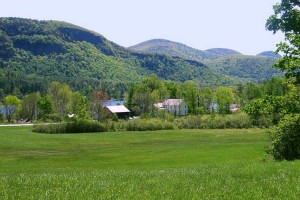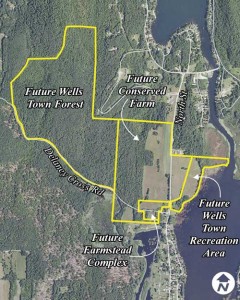
The Vermont Land Trust and the Town of Wells partnered to conserve 300 acres of scenic farm and forestland.
Buying the farm: Vermont Land Trust partners with Wells to conserve farm
Nathaniel Gibson
Correspondent
According to the Vermont Council on Rural Development’s report on the future of Vermont, Vermonters rank “the working landscape and its heritage” more highly as a common value than any other. But practical realities are pulling in the opposite direction. The council predicts that if current trends continue, today’s working landscape will not exist for the next generation. A recent conservation effort in the town of Wells, located in southwestern Vermont, is bucking that trend. The Vermont Land Trust has partnered with the local community to conserve the Delaney farm, a picturesque parcel of over 300 acres of farmland, forest and frontage on Lake St. Catherine.
Since 1977, VLT has been working to preserve the Vermont landscape. To date, the nonprofit has permanently conserved over 1,650 parcels of land covering over 500,000 acres – about 8 percent of the private, undeveloped land in the state. The parcels include more than 700 working farms and hundreds of thousands of acres of forestland, as well as community parks and recreational areas.
Since coming to VLT in 2002, Donald Campbell, southwest regional director for VLT, had been receiving inquiries about the possibility of conserving the Delaney farm, given its choice lakeside location and natural beauty.
The Delaney estate put the farm on the market in the spring of 2010, after the previous owners Joan and Charlotte Delaney passed away in 2008 and 2006, respectively. Given the parcels’ quality, VLT and the Wells Select Board agreed that VLT should try to secure the land while the town raised the funds to purchase portions of it back for community use.
“This is an iconic piece of property,” says Select Board member Rich Strange. “The town doesn’t have any access to the lake, so that was one of the big things we were looking for.”
VLT typically preserves land through conservation easements wherein the organization purchases the rights to future development or subdivision from property owners. Property owners can use the land for farming, forestry, education and other activities that sustain the property, or sell it whenever they wish. When the land changes hands, the conservation easement remains tied to the property, ensuring that the land will be protected in perpetuity.

A map of the Delaney parcel shows the portions to be used for community forest, recreation, and farming.
Because of the time constraints and significance of this property, VLT used capital from a revolving fund and offered $700,000, which was accepted, and took ownership on July 1, 2010. The Select Board then had time to involve its residents, many of whom were already strong supporters of the project, in the process of deciding how to use it. The land was subsequently divided into five parcels: a 105-acre farmland parcel, a 17-acre shoreline parcel, a 170-acre wooded parcel, and two small house lots that VLT is selling to individuals.
The farmland parcel is under contract to Rico and Jill Balzano, through VLT’s farmland access program. The Balzanos have dubbed the land “Little Lake Orchard” and plan to offer community supported agriculture shares and pick-your-own options that will be a source of local food and allow people to walk the land and enjoy its views. Prospective crops include apples, peaches, strawberries, raspberries, plums, apricots and pears.
The 17-acre shoreline parcel will be conserved as a community recreational area. “Part of the Select Board’s vision was that the town might own part of the lake frontage and create a public recreation area for all members of the community to picnic, boat and enjoy the lake up close,” reports Campbell. The town hopes that the property will be an example of sustainable lakefront management minimizing environmental hazards, such as runoff.
The 170-acre wooded parcel, a diverse piece of land featuring a sphagnum bog and multiple vernal pools, could be used for recreation, forestry and education. The Delaney sisters had allowed local residents to hunt on their property, another potential use.
The success of local fund-raising and widespread support for the project among Wells residents have impressed Strange. “The town is thankful that the community has been behind this project the whole way – even though we have had to move fairly quickly,” he reports. Strange hopes that the project will continue to bring residents together as they start using and enjoying it in upcoming months.
When partnering with municipalities, VLT typically requires a management plan with public input. The Select Board will hold a series of public meetings this fall to develop plans for the shoreline and wooded parcels. VLT will retain conservation easements on the parcels, with provisions tailored to the intended uses of the respective areas.
“Working with VLT has been great,” Strange says. “They have the experience and know what works and what doesn’t.”
The project has received support from the Vermont Housing and Conservation Board, an independent state funding agency that is granting $253,500 to VLT for purchase of a conservation easement on the farm parcel. Roughly half this amount is federal funding from the Natural Resource Conservation Service administered by VHCB.
VHCB is also granting $91,000 to Wells for purchase of the forest and shoreline parcels. These grants – combined with approximately $170,000 raised by the town, private foundations and individuals and the bargain prices at which VLT is offering the parcels – should allow the town and the Balzanos to assume ownership of their respective properties by early fall.
Campbell notes that the state is getting a lot of value for its support because of significant matching funds that have been leveraged from federal agencies and more local sources. And the end result – conservation of community land – is a reward beyond measure.
“The Wells community has really been there for us and involved with the process,” observes Campbell. “VLT is there to help communities, but we need to have communities saying what they want.”
Nathaniel Gibson is a freelance writer who lives in Pawlet and may be contacted at www.nathanielrgibson.com.
The article originally appeared in the Rutland Herald and the Times Argus:
September 11, 2011
Section: ENVIRONMENT






